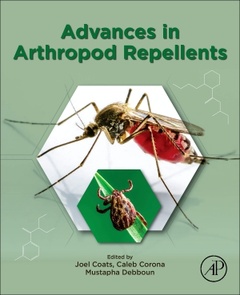Description
Advances in Arthropod Repellents
Coordinators: Coats Joel, Corona Caleb, Debboun Mustapha
Language: English
Subjects for Advances in Arthropod Repellents:
358 p. · 19x23.4 cm · Paperback
Description
/li>Contents
/li>Biography
/li>Comment
/li>
Advances in Arthropod Repellents offers the most current knowledge on arthropod repellents. This area of study is quickly evolving as mosquito- and tick-borne diseases become more prevalent worldwide. Written by global arthropod repellent experts, this book begins by delving into molecule discovery and assay development that is followed by the latest research and investigations of repellent developments and effects. The book then offers readers a look into the global field, semi-field, and laboratory trials using various insect repellents, ranging from Africa, Australia, Europe, South America and the United States. Lastly, it examines the future of spatial repellents and expert insight.
This book is a valuable resource for entomologists and vector control researchers and practitioners. Public health officials and developers in private pest control companies, as well as readers in academia will find this a useful resource to learn the latest information available on controlling the spread of arthropod-borne diseases with repellents.
Part One: Novel Arthropod Repellent Molecule Discovery or Assay Development 1. Introduction: The Role of Arthropod Repellents in Public Health 2. Novel Pyrethroid Derivatives as Effective Mosquito Repellents and Repellent Synergists 3. Biorational Compounds as Effective Arthropod Repellents Against Mosquitoes and Ticks 4. Evaluating Techniques and Efficacy of Arthropod Repellents Against Ticks 5. Evaluation and Application of Arthropod Repellent Treated Uniform/Clothing and Textiles Against Vectors 6. Repelling Mosquitoes with Electric Fields
Part Two: Mechanism of Arthropod Repellent Research and Development 7. Multimodal Mechanisms of Repellency in Arthropods 8. Finding a Repellent Against Ticks: Neurophysiological and Behavioral Approaches 9. Arthropod Repellents and Chemosensory Reception
Part Three: Conducting Arthropod Repellent Studies in Field and Semi-field Trials 10. Semi-field Bioassays for the Evaluation of Spatial (and Topical) Arthropod Repellents for Indoor and Outdoor Use 11. Semi-field Evaluation of Arthropod Repellents: Emphasis on Spatial Repellents 12. Human Subject Studies of Arthropod Repellent Efficacy 13. Arthropod Repellent Research in Northwest Florida
Part Four: The Current Status and Future Uses of Arthropod Repellents 14. The Current Status of Spatial Repellents in the Global Vector Control Community 15. Repellent Semiochemical Solutions to Mitigate the Impacts of Global Climate Change on Arthropod Pests 16. The Role of Arthropod Repellents in the Control of Vector-Borne Diseases
Caleb Corona received his Ph.D. degree in Entomology and Toxicology from the lab of Dr. Joel Coats, Iowa State University, where his research focused on the development of novel insecticides and spatial repellents derived from natural products. He received his B.Sc. degree in Biology with a Chemistry minor from King University in Bristol, Tennessee, where he also served as a Teaching Assistant in Chemistry and later an undergraduate research assistant for federally funded Toxicology laboratory under Dr. Vanessa Fitsanakis . He has been invited as a symposium speaker at the Society for Vector Ecology, the Entomological Society of America, and the American Chemical society multiple times over the course of his career.
Mustapha Debboun has a Ph.D. in Medical and Veterinary Entomology from the University of Missouri-Columbia, is a Board-Certified Entomologist (BCE) with the Entomological Society of America (ESA) and confirmed with the title of Fellow of the ESA. He has more than 27 years of experience in public health entomology, integrated vector
- Discusses recent progress on understanding how insect repellents work, as well as modern methods for finding new molecules and formulations
- Edited by a team whose expertise includes cutting-edge insect repellent research and development
- Serves as a reference and resource that will be useful to a wide variety of professionals, particularly those in public health and vector control




